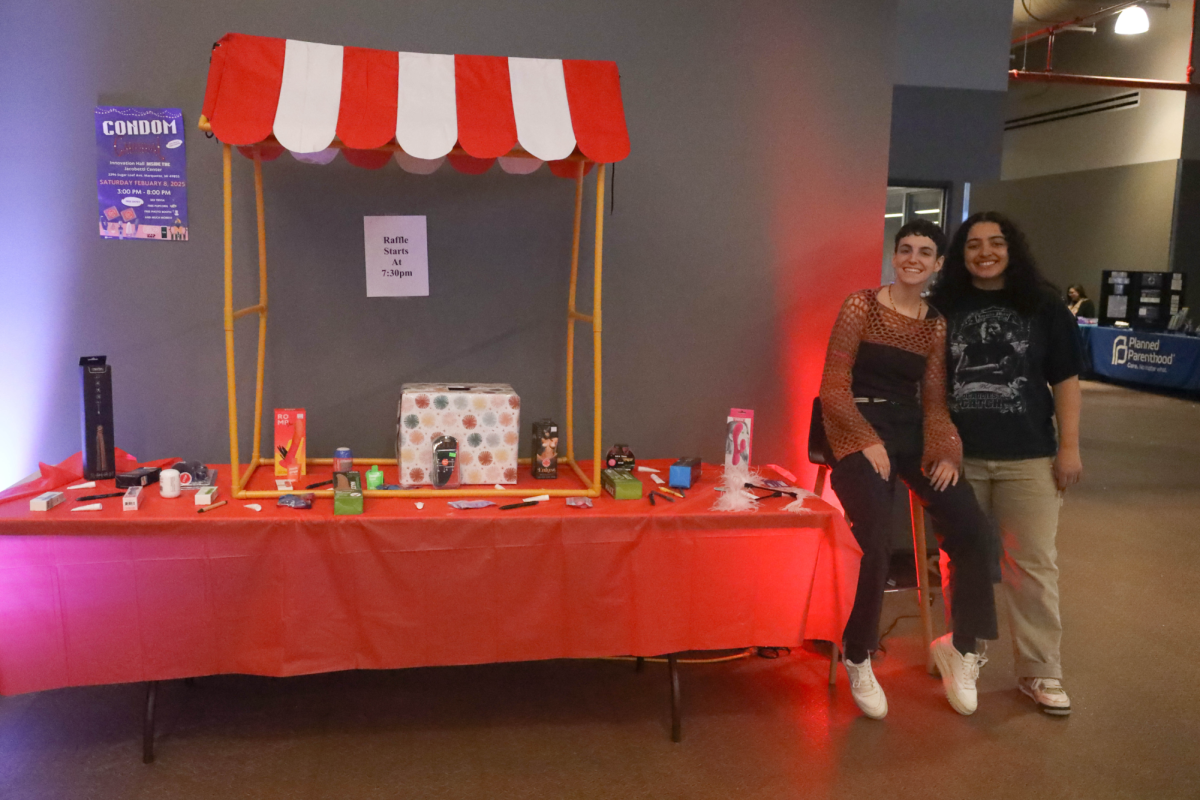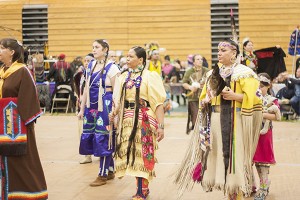Powwows are an integral element to the Native American identity. They are a time to celebrate together and enjoy the presence of kindred spirits on one’s walk through life, while also honoring loved ones who may have walked on. The events serve as a way to share, educate and express Native heritage and embrace one’s culture.
On Saturday, March 14, the NMU Native American Student Association (NASA) hosted the 22nd annual “Learning to Walk Together” traditional powwow at the Vandament Arena. Highlighted was the organization’s goal to promote acceptance among all and educate anyone interested in learning more about Native American heritage.
Many styles of dance were represented. The traditional style has been around long before anyone could remember and is interpretive, acting out a story like hunting or going to war. C.J. Girard, an Objibwa Grass Dancer from the Keweenaw Bay Indian Community, said that his style was influenced by the stomping of grass to make way for a feast area or campground. It features a sweeping motion and waving to mimic the grass itself.
“Grass dancing has been around forever,” Girard said, whose traditional name is Chianang, meaning ‘big star.’ “I’ve been powwow dancing since I could walk. Traditionally my regalia would have actual grass, but now it features cloth.”
The regalia is one of the most precious items of clothing the participants own, a sacred expression of the wearer’s identity. The outfits can feature both traditional and modern elements as they evolve and change as its owner does throughout life. The sacred clothing is never referred to as a costume, as this implies it is an artificial identity.
Another important feature of powwows is the feast. All who attended the powwow were invited to a meal and hand drum competition at the Jacobetti Center. There the audience was reminded that elders, powwow singers and dancers should eat first. Heather McDaniel, a senior multimedia journalism major, said this was a way to honor elders.
“It’s a sign of respect because they are the keepers of knowledge,” McDaniel said. “We need to keep them healthy.”
Katy Matson, a post baccalaureate clinical lab tech student and NASA member, voluntarily served elders, participants and guests alike. The Munising commuter wore multiple hats on top of her regalia Saturday.
“This is my first time helping, but I was on the powwow committee at Michigan State University,” Matson said.
Matson, who majored in microbiology in East Lansing, said the timing of the event played a factor in its multigenerational draw from all over the Great Lakes region.
“In the U.P., the traditional powwows usually run from June until September,” Matson said. “This one and the one at Watersmeet are two of the first ones.”
The feast is a custom that goes back generations and represents eating for those who have walked on. This was done by providing a sample of each dish first to the fire outside of the Vandament Arena. Dr. Martin Reinhardt, an assistant professor of Native American Studies and a citizen of the Sault Ste. Marie tribe of Chippewa Indians helped to organize the meal.
“The reason we have a feast is because when you invite someone over in Indian country, you feed them. We want you to come to the powwow and feel good, so it’s comfort food,” Reinhardt said. “We wanted to serve things that represent our culture, and then lemon bars because they are a nice treat.”
One item missing from the menu was fry bread. Tanner Parish, a freshman and office assistant at NASA, said this was intentional.
“The food at the feast is all from around the area and organic,” Parish said. “That’s one reason the fry bread isn’t there, because that wasn’t introduced until government rations started.”
After the feast, the attendees were invited back to the Vandament Arena. The session began with the Grand Entry, which started with the Honor Guard and Head Veteran Dancer leading participants to a drum beat called the “Flag Song.” Eagle staffs and various flags were carried to remember those who serve the country, and also those who gave the ultimate sacrifice in the line of duty. After the “Flag Song” was a “Veterans’ Honor” song, where veterans from any military branch, Native or Non-Native, were welcome to join the dance.
“It’s to honor the different tribes and elders,” McDaniel said. “It’s like a recognition of the different nations.”
At the end of the powwow, there was a gift-giving ceremony in which elders, participants and members of the audience were honored. This is a tradition that highlights the Native American communities’ value on interdependence, in which someone’s importance is celebrated in a public ceremony.
The powwow represents a communal heritage among the Native American culture, and it wouldn’t have been possible without support from the American Indian Science and Engineering Society, who additionally gave out pies in celebration of National Pi Day and the Native American Language and Culture Club. NMU’s Office of the President, Keweenaw Bay Indian Community, the Multicultural Education and Resource center, many local businesses and community members also helped to provide a positive experience that has lead to the event reaching its 22nd year.


























